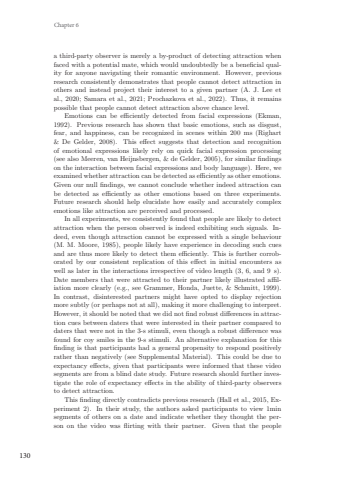Page 132 - Demo
P. 132
130Chapter 6a third-party observer is merely a by-product of detecting attraction whenfaced with a potential mate, which would undoubtedly be a beneficial quality for anyone navigating their romantic environment. However, previousresearch consistently demonstrates that people cannot detect attraction inothers and instead project their interest to a given partner (A. J. Lee etal., 2020; Samara et al., 2021; Prochazkova et al., 2022). Thus, it remainspossible that people cannot detect attraction above chance level.Emotions can be efficiently detected from facial expressions (Ekman,1992). Previous research has shown that basic emotions, such as disgust,fear, and happiness, can be recognized in scenes within 200 ms (Righart& De Gelder, 2008). This effect suggests that detection and recognitionof emotional expressions likely rely on quick facial expression processing(see also Meeren, van Heijnsbergen, & de Gelder, 2005), for similar findingson the interaction between facial expressions and body language). Here, weexamined whether attraction can be detected as efficiently as other emotions.Given our null findings, we cannot conclude whether indeed attraction canbe detected as efficiently as other emotions based on three experiments.Future research should help elucidate how easily and accurately complexemotions like attraction are perceived and processed.In all experiments, we consistently found that people are likely to detectattraction when the person observed is indeed exhibiting such signals. Indeed, even though attraction cannot be expressed with a single behaviour(M. M. Moore, 1985), people likely have experience in decoding such cuesand are thus more likely to detect them efficiently. This is further corroborated by our consistent replication of this effect in initial encounters aswell as later in the interactions irrespective of video length (3, 6, and 9 s).Date members that were attracted to their partner likely illustrated affiliation more clearly (e.g., see Grammer, Honda, Juette, & Schmitt, 1999).In contrast, disinterested partners might have opted to display rejectionmore subtly (or perhaps not at all), making it more challenging to interpret.However, it should be noted that we did not find robust differences in attraction cues between daters that were interested in their partner compared todaters that were not in the 3-s stimuli, even though a robust difference wasfound for coy smiles in the 9-s stimuli. An alternative explanation for thisfinding is that participants had a general propensity to respond positivelyrather than negatively (see Supplemental Material). This could be due toexpectancy effects, given that participants were informed that these videosegments are from a blind date study. Future research should further investigate the role of expectancy effects in the ability of third-party observersto detect attraction.This finding directly contradicts previous research (Hall et al., 2015, Experiment 2). In their study, the authors asked participants to view 1minsegments of others on a date and indicate whether they thought the person on the video was flirting with their partner. Given that the peopleIliana Samara 17x24.indd 130 08-04-2024 16:36


